<Back to Index>
- Botanist Robert Brown, 1773
- Chemist and Physicist Lorenzo Romano Amedeo Carlo Avogadro di Quaregna e di Cerreto, 1776
PAGE SPONSOR
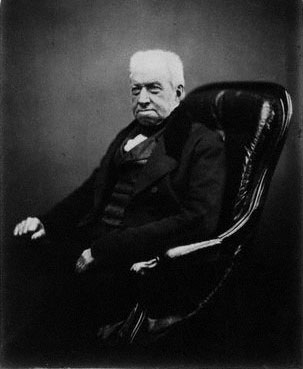
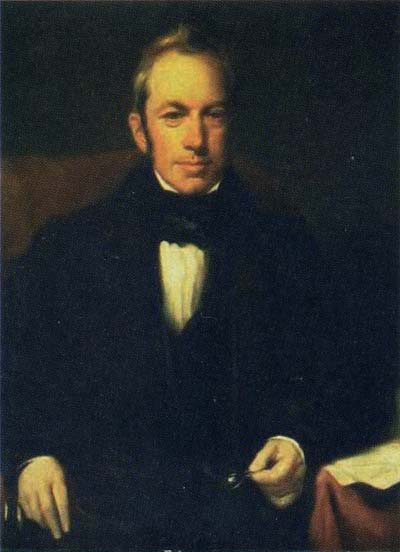
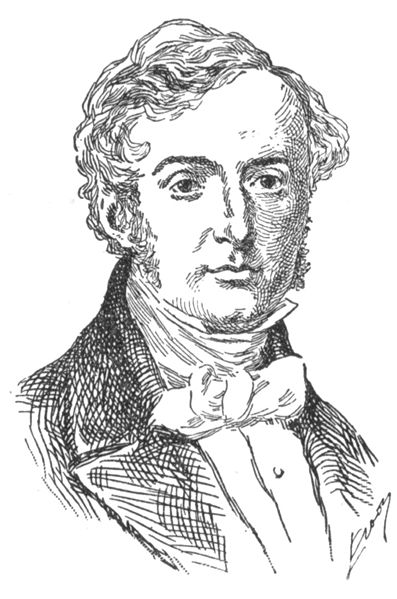
Robert Brown FRSE FRS FLS MWS (21 December 1773 – 10 June 1858) was a Scottish botanist and palaeobotanist who made important contributions to botany largely through his pioneering use of the microscope. His contributions include the discovery of the cell nucleus and cytoplasmic streaming; the first observation of Brownian motion; early work on plant pollination and fertilization, including being the first to recognize the fundamental difference between gymnosperms and angiosperms; and some of the earliest studies in palynology. He also made numerous contributions to plant taxonomy, including the erection of a number of plant families that are still accepted today; and numerous Australian plant genera and species, the fruit of his exploration of that continent with Matthew Flinders.
Brown was born in Montrose on 21 December 1773. He was the son of James Brown, a minister in the Scottish Episcopal Church with Jacobite convictions so strong that in 1788 he defied his church's decision to give allegiance to George III. His mother was Helen née Taylor, the daughter of a Presbyterian minister. As a child Brown attended the local Grammar School (now called Montrose Academy), then Marischal College at Aberdeen, but withdrew in his fourth year when the family moved to Edinburgh in 1790. His father died late the following year.
Brown enrolled to study medicine at the University of Edinburgh, but developed an interest in botany, and ended up spending more of his time on the latter than the former. He attended the lectures of John Walker; made botanical expeditions into the Scottish Highlands, alone or with nurserymen such as George Don;
and wrote out meticulous botanical descriptions of the plants he
collected. He also began corresponding with and collecting for William Withering,
one of the foremost British botanists of his day. Highlights for Brown
during this period include his discovery of a new species of grass, Alopecurus alpinus; and his first botanical paper, "The botanical history of Angus", read to the Edinburgh Natural History Society in January 1792, but not published in print in Brown's lifetime.
Brown dropped out of his medical course in 1793. Late in 1794, he enlisted in the Fifeshire Fencibles, and his regiment was posted to Ireland shortly after. In June 1795 he was appointed Surgeon's Mate. His regiment saw very little action, however, he had a good deal of leisure time, almost all of which he spent on botany. However he was frustrated by his itinerant lifestyle, which prevented him from building his personal library and specimen collection as he would have liked, and cut him off from the most important herbaria and libraries.
During this period Brown was especially interested in cryptogams, and these would be the subject of Brown's first, albeit unattributed, publication. Brown began a correspondence with William Dickson, and by 1796 was sending him specimens and descriptions of mosses. Dickson incorporated Brown's descriptions into his Fasciculi plantarum cryptogamicarum britanniae, with Brown's permission but without any attribution.
By 1800, Brown was firmly established amongst Irish botanists, and
was corresponding with a number of British and foreign botanists,
including Withering, Dickson, James Edward Smith and José Correia da Serra. He had been nominated to the Linnean Society of London; had contributed to Dickson's Fasciculi; was acknowledged in a number of other works; and had had a species of algae, Conferva brownii (now Aegagropila linnaei) named after him by Lewis Weston Dillwyn. He had also begun experimenting with microscopy.
However as an army surgeon stationed in Ireland there seemed little
prospect of him attracting the notice of those who could offer him a
career in botany.
In 1798, Brown heard that Mungo Park had withdrawn from a proposed expedition into the interior of New Holland (now Australia), leaving a vacancy for a naturalist. At Brown's request, Correia wrote to Sir Joseph Banks, suggesting Brown as a suitable replacement:
"Science is the gainer in this change of man; Mr Brown being a professed naturalist. He is a Scotchman, fit to pursue an object with constance and cold mind."
He was not selected, and the expedition did not end up going ahead as originally proposed, though George Caley was sent to New South Wales as a botanical collector for Banks. In 1800, however, Matthew Flinders
put to Banks a proposal for an expedition that would answer the
question whether New Holland was one island or several. Banks approved
Flinders' proposal, and in December 1800 wrote to Brown offering him the
position of naturalist to the expedition. Brown accepted immediately.
Brown was told to expect to sail at the end of 1800, only a few weeks after being offered the position. However a succession of delays meant the voyage did not get under way until July 1801. Brown spent much of the meantime preparing for the voyage by studying Banks' Australian plant specimens and copying out notes and descriptions for use on the voyage.
Though Brown's brief was collect scientific specimens of all sorts, he was told to give priority to plants, insects and birds, and to treat other fields, such as geology, as secondary pursuits. In addition to Brown, the scientific staff comprised the renowned botanical illustrator Ferdinand Bauer; the gardener Peter Good, whose task was to collect live plants and viable seed for the use of Kew Gardens; the miner John Allen, appointed as mineralogist; the landscape artist William Westall; and the astronomer John Crosley, who would fall ill on the voyage out and leave the ship at the Cape of Good Hope. Brown was given authority over Bauer and Good, both of whom were instructed to give any specimens that might collect to Brown, rather than forming separate collections. Both men would provide enthusiastic and hard working companions for Brown, and thus Brown's specimen collections contain material collected by all three men.
The Investigator sailed from London on 18 July. They made brief landfalls at Bugio Island (Desertas Islands) and Madeira, but Brown was disappointed to collect almost nothing of note from either site. They arrived at the Cape of Good Hope on 16 October, staying a little over two weeks, during which time Brown made extensive botanical expeditions, and climbed Table Mountain at least twice. Many years later he would write to William Henry Harvey, who was considering emigrating there, that "some of the pleasantest botanizing he ever had was on Devil's Mountain, near Cape Town, and he thought I could not pitch on a more delightful field of study." Amongst the plants collected at the Cape were two new species of Serruria (Proteaceae), S. foeniculacea and S. flagellaris.
The Investigator arrived in King George Sound in what is now Western Australia in December 1801. For three and a half years Brown did intensive botanic research in Australia, collecting about 3400 species, of which about 2000 were previously unknown. A large part of this collection was lost, however, when the Porpoise was wrecked en route to England.
Brown remained in Australia until May 1805. He then returned to
Britain where he spent the next five years working on the material he
had gathered. He published numerous species descriptions; in Western
Australia alone he is the author of nearly 1200 species.
In early 1809 he read his paper called On the natural order of plants called Proteaceae to the Linnean Society of London. This was subsequently published in March 1810 as On the Proteaceae of Jussieu. It is significant for its contribution to the systematics of Proteaceae, and to the floristics of Australia, and also for its application of palynology to systematics. This work was extensively plagiarized by Richard Anthony Salisbury, who had memorized much of the Linnean reading and then inserted it in Joseph Knight's 1809 publication On the cultivation of the plants belonging to the natural order of Proteeae.
In 1810, he published the results of his collecting in his famous Prodromus Florae Novae Hollandiae et Insulae Van Diemen, the first systematic account of the Australian flora. That year, he succeeded Jonas C. Dryander as Sir Joseph Banks' librarian, and on Banks' death in 1820 Brown inherited his library and herbarium. This was transferred to the British Museum in 1827, and Brown was appointed Keeper of the Banksian Botanical Collection.
In 1818 he published Observations, systematical and geographical, on the herbarium collected by Professor Christian Smith, in the vicinity of the Congo. In 1822, he was elected a Fellow of the Linnean Society and a foreign member of the Royal Swedish Academy of Sciences.
In a paper read to the Linnean society in 1831 and published in 1833, Brown named the cell nucleus. The nucleus had been observed before, perhaps as early as 1682 by the Dutch microscopist Leeuwenhoek, and Franz Bauer had noted and drawn it as a regular feature of plant cells in 1802, but it was Brown who gave it the name it bears to this day (while giving credit to Bauer's drawings). Neither Bauer nor Brown thought the nucleus to be universal, and Brown thought it to be primarily confined to Monocotyledons.
After the division of the Natural History Department of the British Museum into three sections in 1837, Robert Brown became the first Keeper of the Botanical Department, remaining so until his death at Soho Square in London on 10 June 1858. He was succeeded by John Joseph Bennett.
He served as President of the Linnean Society from 1849 to 1853.
He was buried in Kensal Green Cemetery in London.
Brown's name is commemorated in the Australia herb genus Brunonia as well as numerous Australian species such as Eucalyptus brownii, Banksia brownii and the moss Brown's Tetrodontium Moss (Tetrodontium brownianum), a species which he discovered growing at Roslin near Edinburgh whilst still a student. The plant can still be found at the site of its discovery. Passing through the suburb of Kingston, south of Hobart, Tasmania, formerly Van Diemen's Land, is Brown's River, named in his honor, upon the banks of which, he collected botanical samples. Mount Brown in British Columbia, Canada is named for him as well.
In 1827, while examining grains of pollen of the plant Clarkia pulchella suspended in water under a microscope, Brown observed minute particles, now known to be amyloplasts (starch organelles) and spherosomes (lipid organelles), ejected from the pollen grains, executing a continuous jittery motion. He then observed the same motion in particles of inorganic matter, enabling him to rule out the hypothesis that the effect was life related. Although Brown did not provide a theory to explain the motion, and Jan Ingenhousz already had reported a similar effect using charcoal particles, in German and French publications of 1784 and 1785, the phenomenon is now known as Brownian motion.
In recent years it was generally held that Brown's microscopes were
insufficient to reveal phenomena of this order. Brown's re-discoveries
were denied in a brief paper in 1991. Shortly thereafter, in a hastily
compiled illustrated presentation, British microscopist Brian J. Ford
presented to Inter Micro 1991 in Chicago a reprise of the
demonstration. His video sequences substantiated Brown's observations.
Physicist Phil Pearle and colleagues presented a detailed discussion of
Brown's original observations of particles from pollen of Clarkia pulchella undergoing Brownian motion, including the relevant history, botany, microscopy and physics.
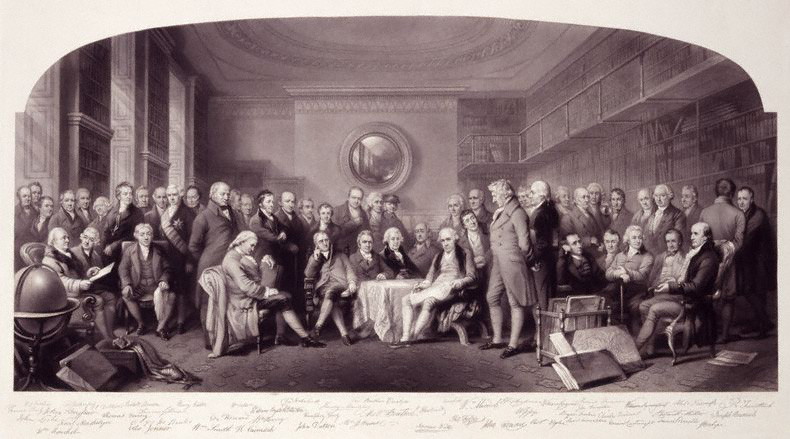
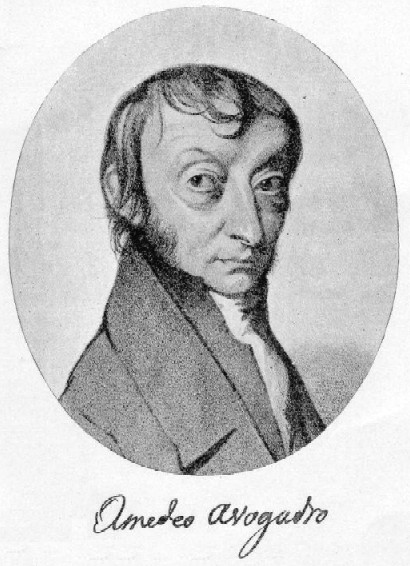
Lorenzo Romano Amedeo Carlo Avogadro di Quaregna e di Cerreto, Count of Quaregna and Cerreto (9 August 1776, Turin, Piedmont – 9 July 1856) was an Italian savant. He is most noted for his contributions to molecular theory, including what is known as Avogadro's law. In tribute to him, the number of elementary entities (atoms, molecules, ions or other particles) in 1 mole of a substance, 6.02214179(30)×1023, is known as the Avogadro constant.
Amedeo Carlo Avogadro was born in Turin, Italy, in 1776 to a noble family of Piedmont, Italy.
He graduated in ecclesiastical law at the early age of 20 and began to practice. Soon after, he dedicated himself to physics and mathematics (then called positive philosophy), and in 1809 started teaching them at a liceo (high school) in Vercelli, where his family had property.
In 1811, he published an article with the title Essai d'une manière de déterminer les masses relatives des molécules élémentaires des corps, et les proportions selon lesquelles elles entrent dans ces combinaisons ("Essay on Determining the Relative Masses of the Elementary Molecules of Bodies and the Proportions by Which They Enter These Combinations"), which contains Avogadro's hypothesis. Avogadro submitted this essay to a French journal, De Lamétherie's Journal de Physique, de Chimie et d'Histoire naturelle (Journal of Physics, Chemistry and Natural History) so it was written in French, not Italian. (Note: In 1811, northern Italy was under the rule of the French Emperor Napoléon Bonaparte.)
In 1820, he became professor of physics at the University of Turin. After the downfall of Napoléon in 1815, northern Italy came under control of the kingdom of Sardinia.
He was active in the revolutionary movements of 1821 against the king of Sardinia (who became ruler of Piedmont with Turin as his capital). As a result, he lost his chair in 1823 (or the university officially declared, it was "very glad to allow this interesting scientist to take a rest from heavy teaching duties, in order to be able to give better attention to his researches").
Eventually, Charles Albert granted a Constitution (Statuto Albertino) in 1848. Well before this, Avogadro had been recalled to the university in Turin in 1833, where he taught for another twenty years.
Little is known about Avogadro's private life, which appears to have been sober and religious. He married Felicita Mazzé and had six children.
Some historians suggest that he sponsored some Sardinian revolutionaries, who were stopped by the announcement of Charles Albert's constitution.
Avogadro held posts dealing with statistics, meteorology and weights and measures (he introduced the metric system into Piedmont) and was a member of the Royal Superior Council on Public Instruction.
In honor of Avogadro's contributions to molecular theory, the number of molecules in one mole was named Avogadro's number, NA or "Avogadro's constant". It is approximately 6.0221415 × 1023. Avogadro's number is used to compute the results of chemical reactions. It allows chemists to determine amounts of substances produced in a given reaction to a great degree of accuracy.
Johann Josef Loschmidt first calculated the value of Avogadro's number, often referred to as the Loschmidt number in German speaking countries (Loschmidt constant now has another meaning).
Avogadro's Law states that the relationship between the masses of the same volume of different gases (at the same temperature and pressure) corresponds to the relationship between their respective molecular weights. Hence, the relative molecular mass of a gas can be calculated from the mass of sample of known volume.
Avogadro developed this hypothesis after Joseph Louis Gay - Lussac had published in 1808 his law on volumes (and combining gases). The greatest problem Avogadro had to resolve was the confusion at that time regarding atoms and molecules. One of his most important contributions was clearly distinguishing one from the other, stating that gases are composed of molecules, and these molecules are composed of atoms. For instance, John Dalton did not consider this possibility. Avogadro did not actually use the word "atom" as the words "atom" and "molecule" were used almost without difference. He believed that there were three kinds of "molecules," including an "elementary molecule" (our "atom"). Also, more attention was given to the definition of mass, as distinguished from weight.
In 1815, he published Mémoire sur les masses relatives des molécules des corps simples, ou densités présumées de leur gaz, et sur la constitution de quelques-uns de leur composés, pour servir de suite à l'Essai sur le même sujet, publié dans le Journal de Physique, juillet 1811 ("Note on the Relative Masses of Elementary Molecules, or Suggested Densities of Their Gases, and on the Constituents of Some of Their Compounds, As a Follow-up to the Essay on the Same Subject, Published in the Journal of Physics, July 1811"), about gas densities.
In 1821 he published another paper, Nouvelles considérations sur la théorie des proportions déterminées dans les combinaisons, et sur la détermination des masses des molécules des corps (New Considerations on the Theory of Proportions Determined in Combinations, and on Determination of the Masses of Atoms) and shortly afterwards, Mémoire sur la manière de ramener les composès organiques aux lois ordinaires des proportions déterminées (Note on the Manner of Finding the Organic Composition by the Ordinary Laws of Determined Proportions).
In 1841, he published his work in Fisica dei corpi ponderabili, ossia Trattato della costituzione materiale de' corpi, 4 volumes.
The scientific community did not give great attention to his theory, so Avogadro's hypothesis was not immediately accepted. André - Marie Ampère achieved the same results three years later by another method (in his Sur la détermination des proportions dans lesquelles les corps se combinent d'après le nombre et la disposition respective des molécules dont leurs particules intégrantes sont composées -- On the Determination of Proportions in which Bodies Combine According to the Number and the Respective Disposition of the Molecules by Which Their Integral Particles Are Made), but the same indifference was shown to his theory as well.
Only through studies by Charles Frédéric Gerhardt and Auguste Laurent on organic chemistry was it possible to demonstrate that Avogadro's law explained why the same quantities of molecules in a gas have the same volume.
Unfortunately, related experiments with some inorganic substances showed seeming exceptions to the law. This was finally resolved by Stanislao Cannizzaro, as announced at Karlsruhe Congress in 1860, four years after Avogadro's death. He explained that these exceptions were due to molecular dissociations at certain temperatures, and that Avogadro's law determined not only molecular masses, but atomic masses as well.
In 1911, a meeting in Turin commemorated the hundredth anniversary of the publication of Avogadro's classic 1811 paper. King Victor Emmanuel III attended. Thus, Avogadro's great contribution to chemistry was recognized.
Rudolf Clausius, with his kinetic theory on gases, gave another confirmation of Avogadro's Law. Jacobus Henricus van 't Hoff showed that Avogadro's theory also held in dilute solutions.
Avogadro is hailed as a founder of the atomic - molecular theory.